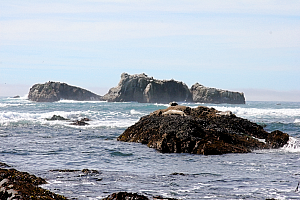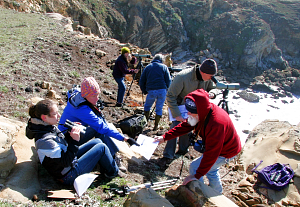Citizen Science Programs

Fort Ross is home to a huge variety of wildlife! We lead and support a number of volunteer-led monitoring programs including Fort Ross' sea lion survey, Point Reyes National Seashore Harbor Seal survey, Beach Watch and iNaturalist Bioblitz events. Starting in 2025 we will be looking for volunteers to assist with plant and butterfly surveys for a new project on restoring Behren's and Myrtle's Silverspot butterfly habitat!
Getting Involved
Interested in getting your feet wet and learning more about your coastline? FRC takes part in three different coastal stewardship surveys at Fort Ross and you are welcome to join us! Taking part in a survey is a great way to increase your understanding of the natural world and helps you to more accurately identify the animals that live on our shores. It’s also great fun! Meet like-minded individuals who share a passion for marine mammals. If you would like to join us for any of these surveys, please email mep@fortross.org
Harbor Seal Surveys
Assist us with our citizen scientist effort monitoring the Harbor Seal population that haul out along our coast. Depending on the season, we undertake Harbor Seal surveys twice a month. These almost two mile low-tide shoreline surveys end at Fort Ross Cove and take about two hours’ time. Trainings happen annually, just before pupping season which starts in March.
 Steller and California Sea Lion Surveys
Steller and California Sea Lion Surveys
Fort Ross' marine mammal surveyors come together to count the number of California and Steller Sea lions and anyone with a passion for marine mammals and being outdoors is welcome to join us. We have resident Steller and Califrnia sea lions that are present year-round that haul-out on islands just offshore from Fort Ross State Historic Park. Sea Lion surveys are scheduled monthly, weather and conditions permitting, and after each survey we enjoy lunch together at the Visitor Center. Fort Ross has more than 10 years of data collected by our wonderful volunteers!
By providing an accurate year-round count of their populations, we hope to understand trends in their populations, if there are any signs of pupping at Fort Ross and take notes on their behavior. While we are counting, we also see grey whales very near to shore, humbpacks passing by and lots of other wildlife.
What have we found? The number of sea lions at Fort Ross has increased by 377% between 2013 and 2023! In January of 2024, we recorded our highest ever count of 413 sea lions.
Beach Watch Survey
Currently, Beach Watch surveys, conducted twice a month, cover Fort Ross Cove and north to Kolmer Gulch as well as the area north from Fisk Mill Cove at Salt Point State Park. To read more about the Farallones Marine Sanctuary Association’s Beach Watch program and to sign up for future trainings, please click on the Farallones link.
Geography
What Marine Mammals Live off the Fort Ross Coast Today?
Several species of marine mammals have re-established populations at Fort Ross
- Steller Sea Lions (habitat, photos, descriptions, identification tips)
- California Sea Lions (habitat, photos, descriptions, identification tips)
- Harbor Seals (habitat, photos, descriptions, identification tips)
These species were plentiful during the Russian era but are rarely seen at Fort Ross today:
- Northern Fur Seal (habitat, photos, descriptions, identification tips)
- California Sea Otter (habitat, photos, descriptions, identification tips)

Monitoring the Marine Mammals at Fort Ross
Today, Fort Ross is home to numerous marine mammal populations. While harbor seals are present along much of the Sonoma coast, Fort Ross’ Sea Lion Rocks, and both Bodega Rock and Ano Nuevo to our south host the most southerly and fragile extension of the Steller sea lion (Eumetopias jubatus) population in the Eastern Pacific..

Volunteer Training
Working with local experts, FRC offers hands-on training in identifying and counting these fabulous creatures. We offer informational sessions during which we will describe the marine mammal observation program at Fort Ross and give you an opportunity to train and sign up to help us with this exciting field work.
This is your opportunity to engage with science at a local level. FRC does field monitoring at least once a month, and once a week during the pupping season.
History
The history of Fort Ross is inextricably tied to the Pacific Ocean’s resources. Russians settled Alaska in their hunt for “soft gold,” and later migrated down the Pacific coast with two primary goals: to find a warmer location whereby they could grow enough food to feed those Alaskan settlements, and to increase the range of marine mammals being hunted. It wasn’t only the Russians hunting marine mammals — it’s worth noting that many nationalities, in particular the Russians, British, and Americans, hunted sea otters, northern fur seals, and other mammals that once thrived along our coast, often trading these goods with the Chinese. Russians and others realized that the hunting was putting many species on the brink of extinction, and they created one of the earliest moratoriums on hunting practices.

We thank California State Parks Foundation for helping launch our Marine Mammal Monitoring program.